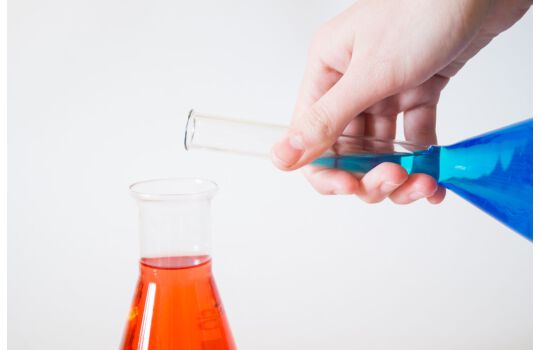Potassium carbonate (K2CO3) is a white salt, which is soluble in water (insoluble in ethanol)[2] and forms a strongly alkaline solution. It can be made as the product of potassium hydroxide's absorbent reaction with carbon dioxide. It is deliquescent, often appearing a damp or wet solid. Potassium carbonate is used in the production of soap and glass.
Contents
1 History
2 Production
3 Applications
4 References
5 Bibliography
6 External links
History
Potassium carbonate is the primary component of potash and the more refined pearl ash or salts of tartar. Historically, pearl ash was created by baking potash in a kiln to remove impurities. The fine, white powder remaining was the pearl ash. The first patent issued by the US Patent Office was awarded to Samuel Hopkins in 1790 for an improved method of making potash and pearl ash.
In late 18th century North America, before the development of baking powder, pearl ash was used as a leavening agent in quick breads.[3]
Production
Today, potassium carbonate is prepared commercially by the electrolysis of potassium chloride. The resulting potassium hydroxide is then carbonated using carbon dioxide to form potassium carbonate, which is often used to produce other Potassium compounds.
2KOH + CO2 → K2CO3 + H2O
Applications
(historically) for soap, glass, and china production
as a mild drying agent where other drying agents, such as calcium chloride and magnesium sulfate, may be incompatible. It is not suitable for acidic compounds, but can be useful for drying an organic phase if one has a small amount of acidic impurity. It may also be used to dry some ketones, alcohols, and amines prior to distillation.[4]
in cuisine, where it has many traditional uses. It is an ingredient in the production of grass jelly, a food consumed in Chinese and Southeast Asian cuisines, as well as Chinese noodles and moon cake. It is used to tenderize tripe. German gingerbread recipes often use potassium carbonate as a baking agent, although in combination with hartshorn. It is however important that the right quantities are used to prevent harm, and cooks should not use it without guidance.
in the production of cocoa powder to balance the pH (i.e., reduce the acidity) of natural cocoa beans; it also enhances aroma. The process of adding potassium carbonate to cocoa powder is usually called "Dutching" (and the products referred to as Dutch-processed cocoa powder), as the process was first developed in 1828 by Coenrad Johannes van Houten, a Dutchman.
as a buffering agent in the production of mead or wine.
in antique documents, it is reported to have been used to soften hard water.[5]
as a fire suppressant in extinguishing deep-fat fryers and various other B class-related fires.
in condensed aerosol fire suppression, although as the byproduct of potassium nitrate.
as an ingredient in welding fluxes, and in the flux coating on arc-welding rods.
as an animal feed ingredient to satisfy the potassium requirements of farmed animals such as broiler breeders.
as an acidity regulator in Swedish snus


